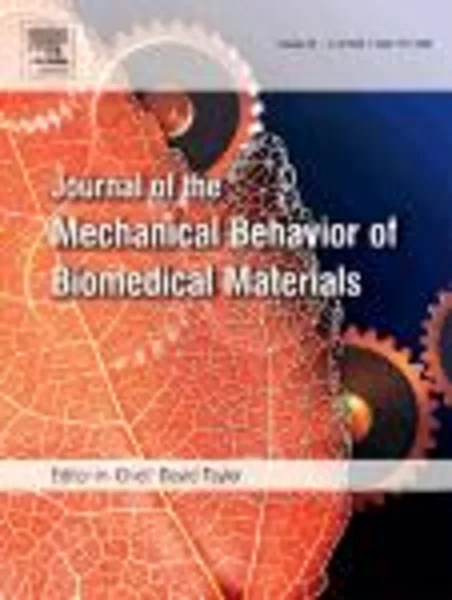-
non-destructive characterization of microdamage in cortical bone using low field pulsed nmr
جزئیات بیشتر مقاله- تاریخ ارائه: 1394/01/01
- تاریخ انتشار در تی پی بین: 1394/01/01
- تعداد بازدید: 724
- تعداد پرسش و پاسخ ها: 0
- شماره تماس دبیرخانه رویداد: -
the microcracking and damage accumulation process in human cortical bone was characterized by performing cyclic loading under four-point bending at ambient temperature. a non-destructive nuclear magnetic resonance (nmr) spin–spin (t2) relaxation technique was applied to quantify the apparent changes in bone porosity as a function of cyclic loading and prior damage accumulation, first to unloaded cortical bone to quantify the initial porosity and then to fatigued cortical bone that was subjected to cyclic loading to various levels of modulus degradation and microdamage in the form of microcracks. the nmr t2 relaxation time and amplitude data of the fatigued bone were compared against the undamaged state. the difference in the t2 relaxation time data was taken as a measure of the increase in pore size, bone porosity or microcrack density due to microdamage induced by cyclic loading. a procedure was developed to deduce the number and size distributions of microcracks formed in cortical bone. serial sectioning of the fatigued bone showed the formation of microcracks along the cement lines or within the interstitial tissue. the results on the evolution of microdamage derived from nmr measurements were verified by independent experimental measurements of microcrack density using histological characterization techniques. the size distribution and population of the microcracks were then utilized in conjunction with an analytical model to predict the degradation of the elastic modulus of cortical bone as a function of damage accumulation.
مقالات جدیدترین رویدادها
-
استفاده از تحلیل اهمیت-عملکرد در ارائه الگوی مدیریت خلاقیت سازمانی و ارائه راهکار جهت بهبود
-
بررسی تاثیر ارزش وجوه نقد مازاد بر ساختار سرمایه شرکت های پذیرفته شده در بورس اوراق بهادار تهران
-
بررسی تأثیر سطح افشای ریسک بر قرارداد بدهی شرکت های پذیرفته شده در بورس اوراق بهادار تهران
-
بررسی تأثیر رتبه بندی اعتباری مبتنی بر مدل امتیاز بازار نوظهور بر نقد شوندگی سهام با تأکید بر خصوصی سازی شرکت ها
-
تأثیر آمیخته بازاریابی پوشاک ایرانی بر تصویر ذهنی مشتری پوشاک ایرانی (هاکوپیان)
-
معرفی و مقایسه روش های تعیین سرفاصله در حمل و نقل همگانی
-
چگونگی ایفای نقش بانک مرکزی در بازارهای ارز و پول
-
تحلیل پایداری قطار شهری شیراز با استفاده از نرم افزار twofs و مقایسه با روابط تجربی
-
natural convection from inclined plates to gases and liquids when both sides are uniformly heated at the same temperature
-
effect of near- field ground motions on the stability of embankment dams
مقالات جدیدترین ژورنال ها
-
مدیریت و بررسی افسردگی دانش آموزان دختر مقطع متوسطه دوم در دروان کرونا در شهرستان دزفول
-
مدیریت و بررسی خرد سیاسی در اندیشه ی فردوسی در ادب ایران
-
واکاوی و مدیریت توصیفی قلمدان(جاکلیدی)ضریح در موزه آستان قدس رضوی
-
بررسی تاثیر خلاقیت، دانش و انگیزه کارکنان بر پیشنهادات نوآورانه کارکنان ( مورد مطالعه: هتل های 3 و 4 ستاره استان کرمان)
-
بررسی تاثیر کیفیت سیستم های اطلاعاتی بر تصمیم گیری موفق در شرکتهای تولیدی استان اصفهان (مورد مطالعه: مدیران شرکتهای تولیدی استان اصفهان)
-
بررسی تاثیر چابکی سازمانی و خلاقیت سازمانی بر عملکرد شغلی کارکنان بانک توسعه صادرات ایران
-
اصطلاحات نجومی و بازتاب آن در شعر برخی از شاعران
-
«فمنیسم پسااستعماری و جنبش متقدم زنان در ایران» دیگری سازی و مناسبات سلطه
-
مدلی برای تحقق اهداف اقتصاد مقاومتی در بیمارستان (مطالعه موردی: بیماران مبتلا به بیماری های خاص)
-
the study of electron-orbital properties of bipolar energy of complex (2,6-diaminopyridinium bis (4-hydroxy-pyridine-2,6,6-dicarboxylate) dihydrate chromate iii))) with alteration of ligands by computational methods




سوال خود را در مورد این مقاله مطرح نمایید :